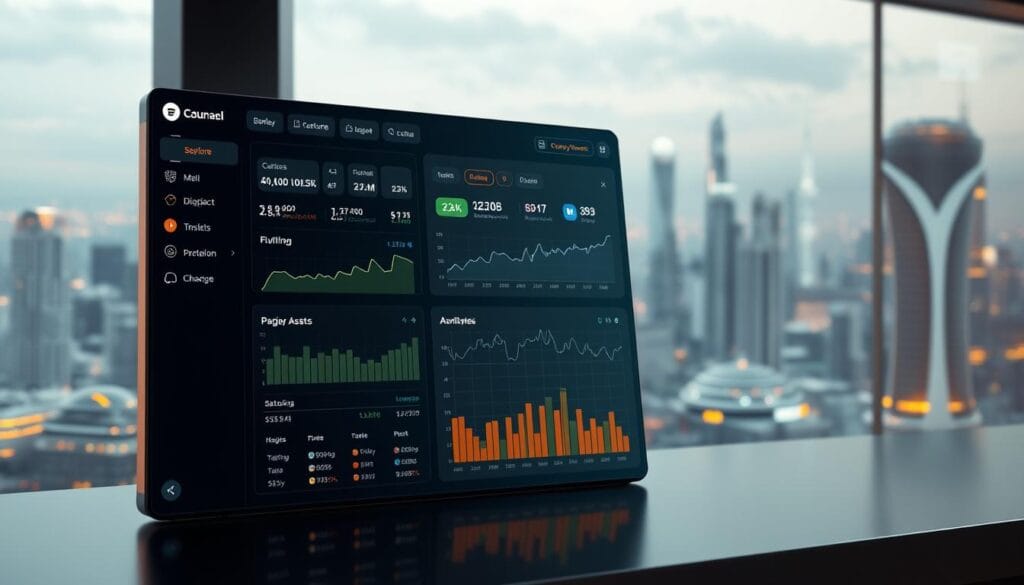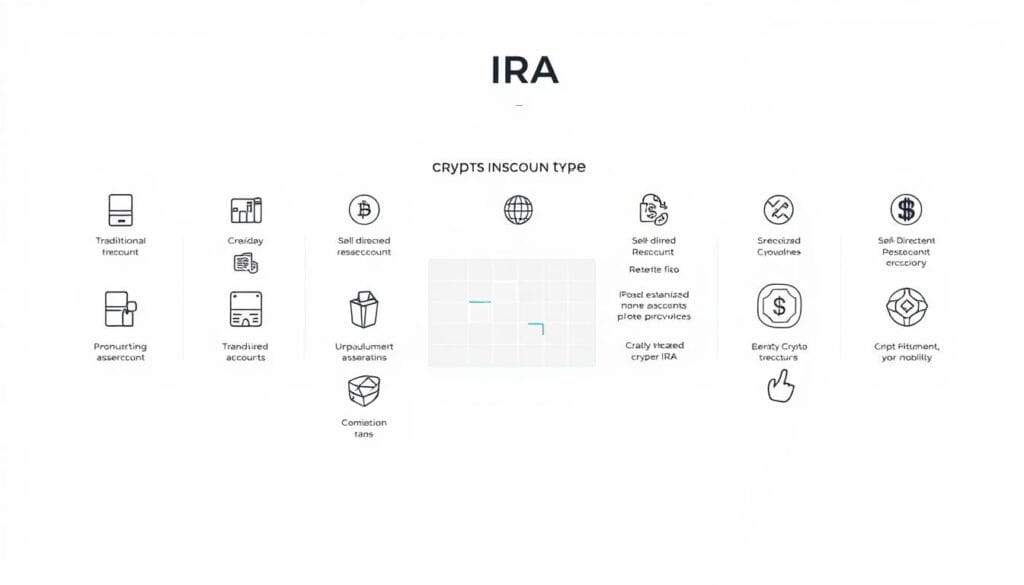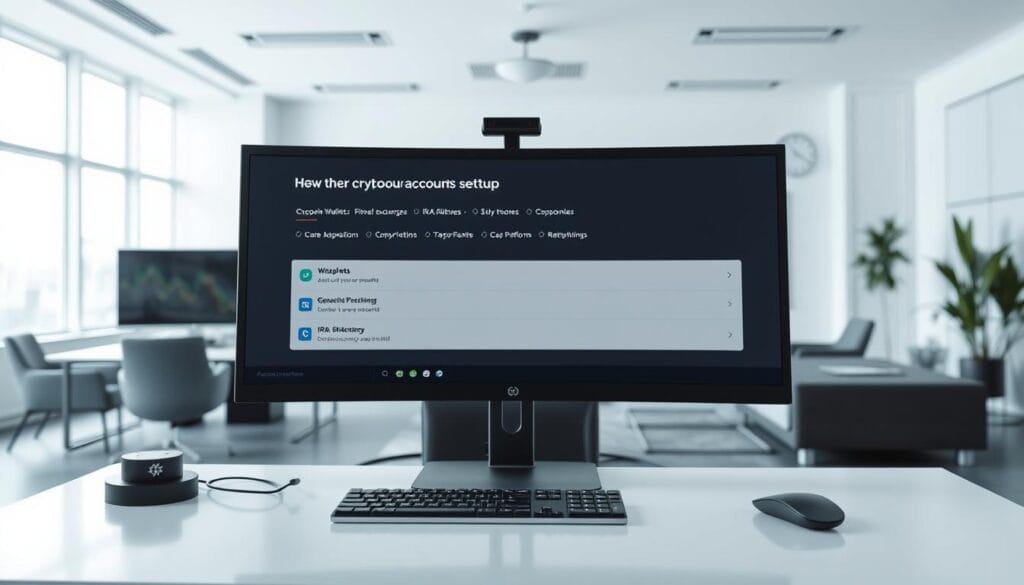Did you know that over 21% of Americans are now considering digital assets as part of their retirement strategy? As the financial landscape evolves, more investors are looking for ways to diversify their portfolios beyond traditional stocks and bonds. This shift has led to the growing adoption of crypto-based retirement accounts, offering unique benefits like tax advantages and institutional-grade security.
Platforms like Fidelity Crypto® IRA and Alto IRA are leading the charge, providing robust solutions for those looking to secure their future. With features such as cold storage and multi-signature authorization, these accounts ensure your assets remain safe while offering access to over 250 investment opportunities. However, it’s essential to understand the risks, including market volatility and regulatory changes, before diving in.
For a deeper dive into how these accounts work and their potential benefits, check out our guide on effective crypto trading strategies for 2025. This resource can help you make informed decisions about your retirement planning.
Key Takeaways
- Over 21% of Americans are exploring digital assets for retirement diversification.
- Crypto-based accounts offer tax advantages and institutional-grade security.
- Platforms like Fidelity Crypto® IRA and Alto IRA provide diverse investment options.
- Risks include market volatility and regulatory uncertainty.
- Understanding these accounts is crucial for informed retirement planning.
What Are Cryptocurrency IRA Options?

Investors are increasingly turning to innovative accounts to diversify their portfolios. Self-directed accounts allow individuals to hold digital assets like Bitcoin and Ethereum under IRS guidelines. These accounts offer a unique way to blend traditional retirement planning with modern investment opportunities.
Understanding the Basics of Cryptocurrency IRAs
Self-directed accounts provide flexibility by allowing investments in digital assets. For 2025, the contribution limit is set at $7,000, which differs from traditional account caps. This higher limit makes them an attractive option for those looking to maximize their retirement savings.
Custody of assets varies by provider. For example, Coinbase safeguards Alto IRA assets, while Fidelity uses in-house cold storage. These methods ensure security and peace of mind for investors.
How Cryptocurrency IRAs Differ from Traditional IRAs
Tax treatment is a key difference. Roth accounts offer tax-free withdrawals, while Traditional accounts provide tax deferral. This distinction can significantly impact long-term financial planning.
Self-directed accounts also come with unique rules. Prohibited transactions, such as using assets for personal gain, are strictly enforced. Understanding these rules is crucial for compliance and maximizing benefits.
For those considering a rollover, platforms like iTrustCapital allow 401(k)/403(b) rollovers with a 1% transaction fee. This option can simplify the transition to a self-directed account. Learn more about retirement planning strategies to make informed decisions.
Why Consider Cryptocurrency IRAs in 2025?

The financial landscape is evolving, and digital assets are becoming a key part of retirement strategies. With traditional investments facing challenges, these assets offer a fresh perspective for securing financial futures. In 2025, tax advantages and diversification benefits make them an attractive option for investors.
Tax Advantages of Cryptocurrency IRAs
One of the most compelling reasons to consider these accounts is their tax benefits. Roth accounts, for example, allow for tax-free growth after a five-year holding period. Qualified distributions post-59½ are exempt from capital gains tax, providing significant long-term savings.
Traditional accounts, on the other hand, offer tax-deferred growth. This means contributions are made with pre-tax dollars, reducing taxable income in the present. Both options provide unique ways to maximize retirement savings while minimizing tax burdens.
Diversification Benefits for Your Retirement Portfolio
Diversification is a cornerstone of sound financial planning. Digital assets like Bitcoin have a low correlation with traditional investments such as the S&P 500, with a correlation coefficient of just 0.36 in 2024. This makes them an effective hedge against market volatility.
Additionally, these assets can serve as a hedge against inflation. Unlike traditional bonds, which may lose value during inflationary periods, digital assets often retain or increase their worth. However, it’s important to balance your portfolio. The SEC recommends allocating no more than 5% to these assets to mitigate concentration risks.
For those looking to explore more strategies, check out our guide on low-fee robo-advisors for 2025. This resource can help you make informed decisions about your financial future.
Top Cryptocurrency IRA Providers for 2025

Choosing the right platform for your digital asset investments can significantly impact your financial future. In 2025, several providers stand out for their unique features, competitive fees, and robust security measures. Below, we explore three leading platforms to help you make an informed decision.
Fidelity Crypto® IRA: A Comprehensive Solution
Fidelity Crypto® IRA offers a comprehensive solution for investors seeking institutional-grade security. With $0 account fees and a 1% spread on trades, it’s a cost-effective choice. The platform uses cold storage to safeguard assets, ensuring maximum protection against cyber threats.
Additionally, Fidelity’s in-house custody service provides peace of mind for users. This feature, combined with its user-friendly interface, makes it a top choice for both beginners and experienced investors.
Alto IRA: Best for Low-Cost Trading
Alto IRA is ideal for those looking for low-cost trading options. With a $10 minimum and a 1% transaction fee, it’s accessible to a wide range of investors. The platform partners with Coinbase, offering access to over 250 digital assets.
This extensive selection makes Alto IRA a versatile choice for diversifying your portfolio. Its straightforward fee structure and seamless integration with Coinbase further enhance its appeal.
iTrustCapital: Competitive Rates and Fees
iTrustCapital stands out for its competitive rates and 24/7 trading capabilities. With a $1,000 minimum and a 1% fee, it’s a flexible option for investors. The platform also allows rollovers from 401(k)/403(b) accounts, simplifying the transition to digital asset investments.
Its no monthly fees policy and robust security protocols make iTrustCapital a reliable choice. For those looking to explore more investment strategies, check out our guide on micro-investing platforms.
When selecting a platform, consider factors like fees, security, and asset diversity. Each provider offers unique strengths, so choose one that aligns with your financial goals and risk tolerance.
Types of Cryptocurrency IRAs Available

Retirement planning in 2025 offers diverse account options tailored to modern financial goals. Understanding the differences between these accounts can help you make informed decisions about your future. Below, we explore the key types available and their unique benefits.
Traditional Accounts
Traditional accounts provide immediate tax deductions on contributions. This means you can reduce your taxable income in the year you make the contribution. For 2025, the contribution limit is $7,000, with an additional $1,000 catch-up for those aged 50 and older.
These accounts are ideal for individuals who expect to be in a lower tax bracket during retirement. However, withdrawals are taxed as ordinary income, so planning is essential to maximize benefits.
Roth Accounts
Roth accounts operate differently. Contributions are made with after-tax dollars, meaning there’s no immediate tax deduction. However, qualified withdrawals, including earnings, are tax-free after age 59½ and a five-year holding period.
This structure makes Roth accounts a powerful tool for long-term growth. For example, $10,000 invested in a Roth account could grow significantly over 20 years without incurring capital gains tax.
Rollover Accounts
Rollover accounts allow you to transfer funds from a 401(k) or 403(b) into a self-directed account. Equity Trust Company, for instance, facilitates this process with a 2% purchase fee. The transfer must be completed within a 60-day window to avoid penalties.
This option is particularly useful for those looking to consolidate retirement savings. However, it’s crucial to understand the rules and fees associated with rollovers to make the most of this strategy.
When choosing an account, consider factors like tax treatment, income limits, and long-term goals. For single filers, Roth accounts phase out at $146,000, so eligibility is an important consideration. Additionally, prohibited transactions, such as using account funds for personal gain, can result in IRS penalties. Always consult a financial advisor to ensure compliance and maximize your retirement savings.
How to Open a Cryptocurrency IRA

Opening a digital asset retirement account is a straightforward process when you know the steps. Whether you’re a seasoned investor or new to this space, understanding the setup and funding process is essential. Below, we break down the key steps to help you get started.
Step-by-Step Guide to Setting Up Your Account
First, gather the necessary documentation. You’ll need your Social Security Number (SSN), a government-issued ID, and beneficiary forms. These are standard requirements for most providers.
Next, choose a platform that aligns with your goals. For example, Fidelity requires a linked brokerage account and follows a 3-step setup process. Alto, on the other hand, has a $10 minimum and accepts ACH, wire, or rollover transfers.
Once your account is open, you’ll need to fund it. Funding methods vary by provider. Alto offers same-day ACH transfers, while Equity Trust charges a $50 application fee. Be sure to compare these options to find the best fit for your needs.
Funding Your Digital Asset Retirement Account
Funding your account is a critical step. Most platforms allow you to transfer money via ACH, wire, or rollover. For example, Fidelity converts USD to Bitcoin at market rates the next business day.
If you’re considering a rollover, understand the logistics. Direct transfers are typically faster and avoid penalties, while indirect transfers must be completed within 60 days. Always confirm the details with your provider to ensure a smooth process.
Finally, keep an eye on contribution deadlines. For the 2025 tax year, the deadline is April 15, 2026. Missing this date could result in penalties or lost opportunities for tax advantages.
For more insights on managing your investments, explore our guide on top digital assets to invest in for.
Security Measures in Cryptocurrency IRAs

Protecting your digital investments is crucial in today’s financial landscape. With the rise of digital assets, ensuring their safety has become a top priority for investors. This section explores the key security measures that safeguard your assets and minimize risk.
Cold Storage and Institutional-Level Security
One of the most effective ways to protect digital assets is through cold storage. This method keeps assets offline, significantly reducing the risk of hacking. For example, Fidelity stores 95% of its assets in offline cold storage, ensuring maximum protection.
Cold storage is particularly effective compared to hot wallets, which are connected to the internet. Studies show that cold storage reduces hack risks by 98%, making it a preferred choice for institutional-grade security.
Multi-Signature Authorization and Insurance
Another layer of protection is multi-signature authorization. This requires multiple keys to access assets, adding an extra level of control. BitIRA, for instance, uses a 3-key system, while Unchained allows clients to hold their own keys.
Insurance also plays a vital role in safeguarding investments. BitIRA offers a $250M crime insurance policy, while Unchained provides $250K FDIC cash coverage. These policies ensure that your assets are protected against unforeseen events.
For more insights on securing your investments, explore our guide on secure digital wallets for 2025.
Regulatory compliance is another critical aspect. Platforms like Fidelity Digital Assets operate under NYDFS oversight, ensuring adherence to strict security standards. This regulatory framework provides added trust and reliability for investors.
Finally, it’s essential to plan for inheritance. Key succession protocols ensure that your assets are transferred securely to beneficiaries, avoiding potential complications. Always verify these protocols with your provider to ensure a seamless transition.
Fees and Costs Associated with Cryptocurrency IRAs
Understanding the fees associated with digital asset accounts is essential for informed decision-making. These costs can vary widely across providers, impacting your long-term financial strategy. By breaking down the components of these fees, you can make smarter investment choices.
Understanding Account Maintenance and Trading Fees
When evaluating a platform, it’s important to consider both account maintenance and trading fees. For example, Fidelity offers $0 account fees but charges a 1% spread on trades. On the other hand, Bitcoin IRA includes a 2.99% setup fee and 2% trade fees, which can add up quickly.
Hidden costs can also impact your investment. BitIRA, for instance, charges a 1% liquidity fee on withdrawals. Always review the fee structure carefully to avoid unexpected expenses.
Comparing Fees Across Providers
Comparing costs across providers can help you find the best fit for your financial goals. iTrustCapital charges a flat 1% transaction fee with no setup or recurring fees, making it a cost-effective option. Alto IRA, with its $10 minimum and 1% trading fee, is another affordable choice for smaller investors.
Institutional providers like Fidelity often have scale advantages, offering lower fees for larger accounts. For accounts over $250k, some providers, such as Equity Trust, even allow fee negotiation.
For a detailed comparison of providers, check out this guide on the best digital asset accounts.
Risks and Considerations of Cryptocurrency IRAs
Investing in digital assets for retirement comes with unique challenges that require careful consideration. While these investments offer potential rewards, they also carry significant risks that investors must understand. From market volatility to regulatory uncertainties, navigating this space demands a strategic approach.
Volatility and Market Risks
One of the most prominent risks is market volatility. For example, Bitcoin’s 30-day volatility in 2025 is 5.2%, compared to the S&P 500’s 1.1%. This unpredictability can lead to significant price swings, as seen during the 2022 bear market when Bitcoin’s value dropped by 65%.
Such fluctuations can impact long-term retirement planning. Investors must be prepared for potential drawdowns and consider diversifying their portfolios to mitigate these risks.
Regulatory and Compliance Challenges
Regulatory uncertainty is another critical factor. The SEC’s 2023 lawsuit against Coinbase highlights the evolving legal landscape. Additionally, IRS Notice 2014-21 classifies digital assets as property for tax purposes, affecting how gains and losses are treated.
Proposed regulations, such as the FIT21 Act, could introduce stricter custody requirements, further complicating the process. Geopolitical events, like China’s ban on mining, also add layers of complexity.
Investors should stay informed about these changes and consult financial advisors to ensure compliance. For more insights, explore Fidelity’s guide on digital asset investments.
Conclusion
As 2025 approaches, the landscape for digital asset investments continues to evolve, offering new opportunities for diversification. With cryptocurrency volatility at a three-year low, this year presents an optimal window for investors to explore these assets as part of their retirement strategy.
When selecting a provider, it’s essential to weigh their strengths. Fidelity offers unmatched security with institutional-grade cold storage, while Alto stands out for its affordability and low-cost trading options. Conducting thorough due diligence, such as verifying SOC 2 certifications and insurance binders, is mandatory to ensure asset safety.
Experts recommend limiting digital asset allocations to no more than 5% of your portfolio to mitigate risks. Consulting with certified tax professionals is also crucial to maximize gains and ensure compliance. For more insights, explore the future of digital asset investments.

